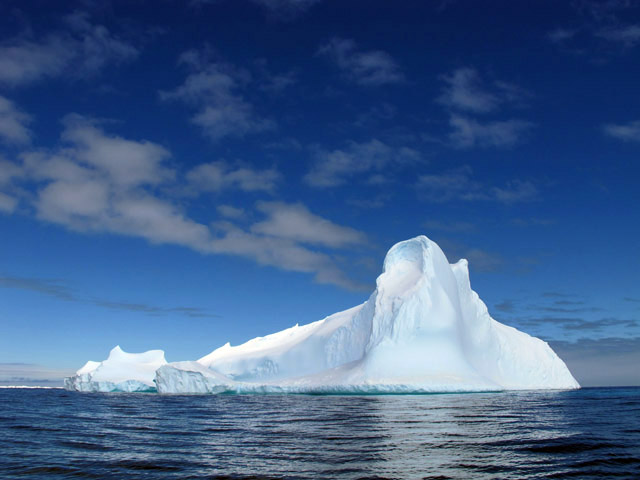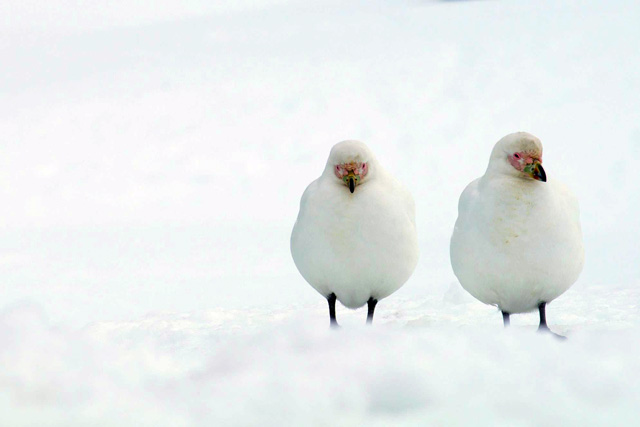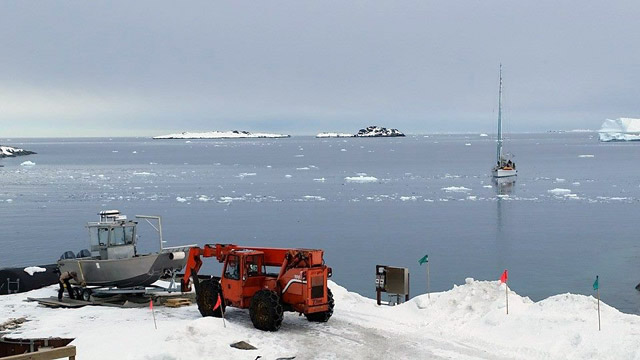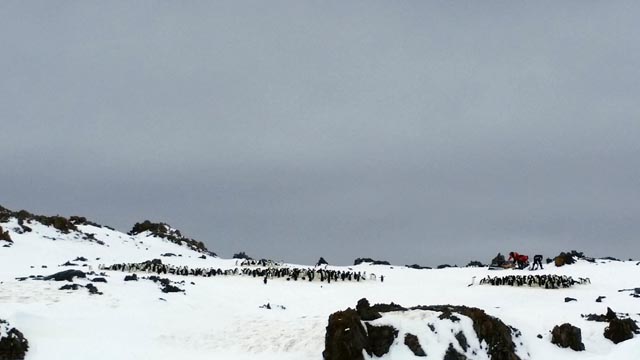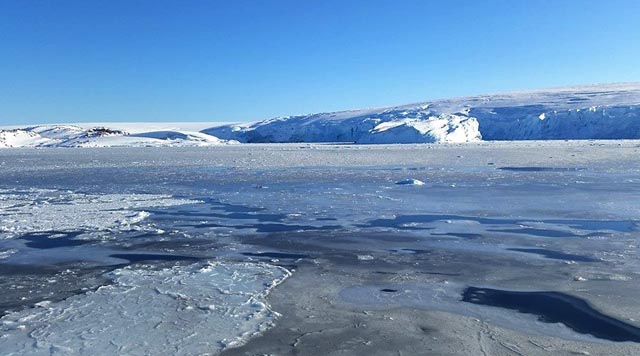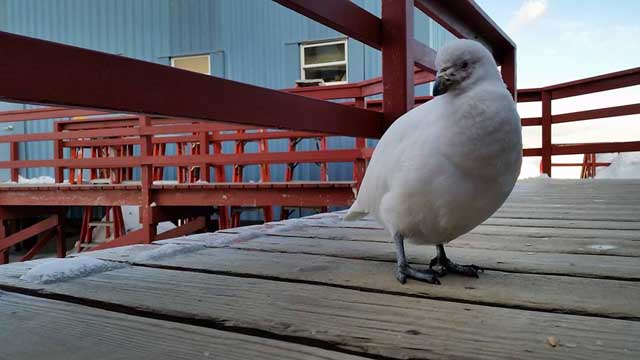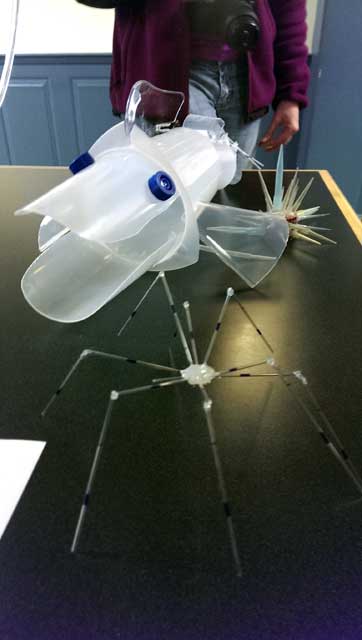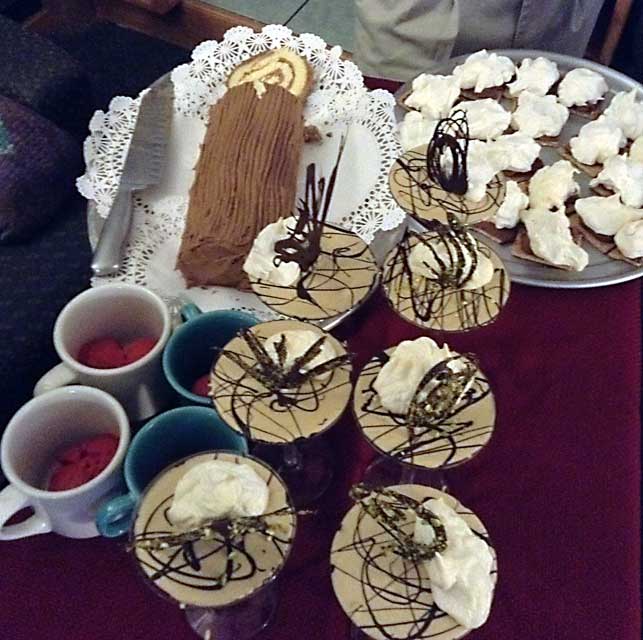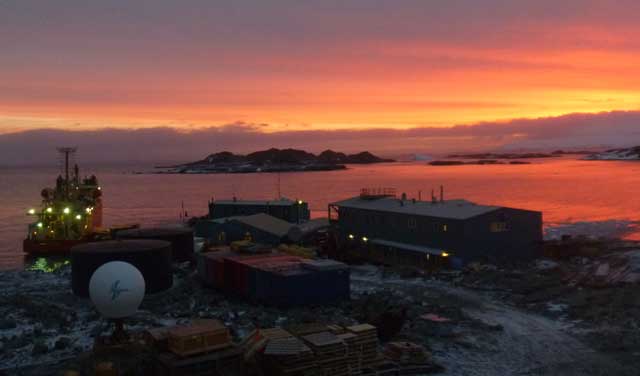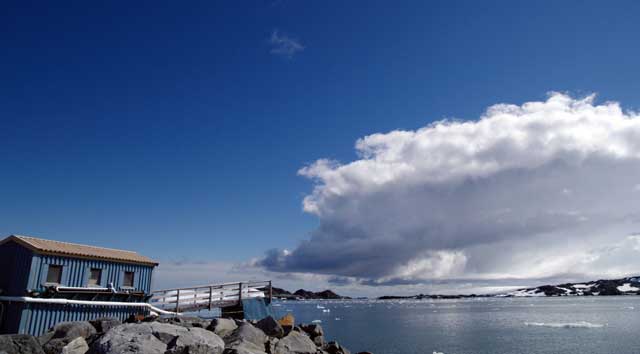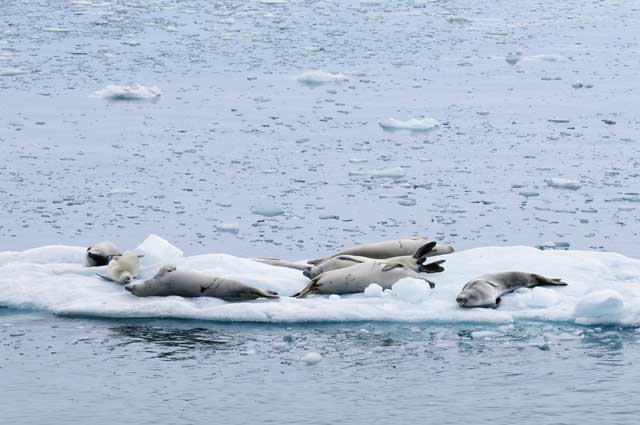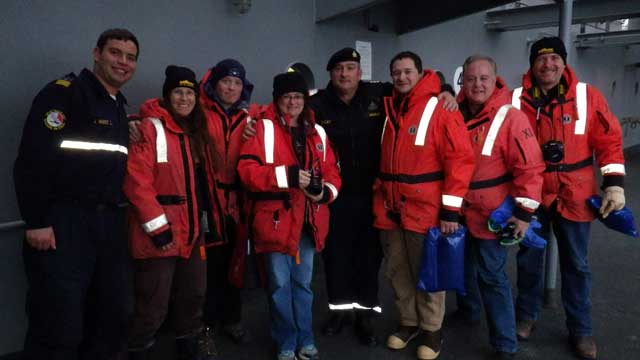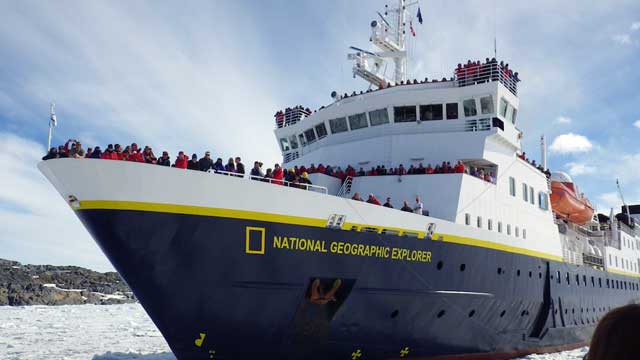|
Palmer Station Archives - 2014 Good weather allows researchers to go farther afield from Palmer StationDecember 11, 2014
Don’t blink – because if you do, a month in Antarctica will be over before you know it. November came and went in a flash, as the summer field season kicked into full operation, with new science groups at Palmer Station, along with visits by cruise ships and even naval vessels. Shortly after the start of November, the research vessel Laurence M. Gould arrived at Palmer, bringing in a new research team here to study pteropods. Pteropods are kind of like sea-dwelling snails with wings. Their shells are very sensitive to changes in the ocean’s acidity. For the researchers, the pteropod is the ocean’s version of a canary in a coal mine in terms of assessing the effects of ocean acidification on marine animals with shells. Seawater absorbs carbon dioxide (CO2) from the atmosphere, lowering the pH and increasing acidity. As that happens, a pteropod’s shell will start to degrade, changing its buoyancy and affecting the way it propels itself through the water column. The group hopes to use high-tech methods like videography and particle image velocimetry, an optical method to determine fluid velocity among other properties, to better understand how the pteropods propel themselves and how that might change in different ocean conditions. Thanks to the continual improvement in the weather, the science groups connected to the Palmer Long Term Ecological Research (LTER) program have been able to go out and perform water column sampling with more regularity. During a typical sampling period, the groups will leave station early in the morning and head to the limits of the Palmer boating area about two miles away where they will spend hours collecting water and using computerized instruments to collect data in one location before moving onto the next. A typical sampling day will see the groups out on the water for six to eight hours at any one time, followed by many hours in the lab processing the newly collected samples. Bird biologists with LTER have also been enjoying better weather for making their observations on the local seabird populations including penguins. The improved weather allows them to head off to Dream and Biscoe islands, which lie outside of the normal Palmer boating area. In order to head to these islands, the weather needs to fall into a narrow range of near-ideal conditions for the safety of the scientists and for the ability of station personnel to be able to respond in case of an emergency. While Torgersen Island in the Palmer boating area is home to Adélie penguins, Biscoe and Dream islands are also home to gentoo and chinstrap penguins that have been showing up in greater numbers each year as the climate changes. The first two cruise ships of the summer season arrived with several boatloads of tourists eager to learn more about Palmer Station and Antarctica. A cruise ship visit is major undertaking for our small station. Most of the Palmer staff will end up assisting in the visits in one way or another. This could be as a tour guide, a helper in the station store, or even just assisting to set up the Palmer dining room as a reception area for the guests. The National Science Foundation typically limits cruise ship visits to 12 per austral summer because each visit has so much impact in station operations. Naval ships are another matter. Usually several times a season a naval ship connected with another country’s Antarctic operations will request a visit to Palmer. These visits require just a handful of people to support. It helps that a naval ship will typically only have 20 to 30 people ashore during a visit versus the 150 to 200 passengers from cruise ships. Yachts are the final type of vessel that visits Palmer. It was near the end of the month when we had our first yacht visit. Aboard the yacht was a small crew from the HBO show VICE. They spent three days in the Palmer area filming and interviewing the science groups on station. The footage and interviews are planned to be part of a larger episode about climate change, which should air sometime around the beginning of March. Shortly after the HBO crew left, the station celebrated Thanksgiving to end the month. The dining area was filled with a thankful crew rather than family from home – but for many of us at Palmer, our fellow team members have become a second family. The view from Palmer Station clears up with weather and webcamNovember 13, 2014
Winter’s grip on Palmer Station started to loosen during October. Snow continued to accumulate for most of the month, with several areas drifting in continuously with the help of cold winds from the south, as well as winds that would howl over the nearby glacier. Earlier in the month, the research vessel Laurence M. Gould returned to station with three science groups. Two of the teams are associated with the Palmer Long Term Ecological Research (LTER). The Palmer LTER program has been active in the northwestern region of the Antarctic Peninsula since 1990. Each year scientists will arrive at Palmer Station early in the austral summer to study local seabird populations, including Adélie penguins, and sample the local marine environment. In January, a month-long research cruise takes place aboard the Gould as part of the LTER program. During this cruise, the ship will traverse a predetermined sampling grid along the Antarctic Peninsula. The data collected will be available to not only the researchers performing the research, but it will also be posted online so that other scientists can use the data, too. Palmer is a coastal research station, so much of the science based here involves going out on small inflatable boats, Zodiacs, to collect water samples or to observe nesting populations of seabirds on nearby islands. Before that can happen, scientists and station personnel need to be trained on how to operate the Zodiacs in the Palmer area, limited to a two-mile radius. Because of extensive sea ice and windy weather, this wasn’t able to happen until near the end of October. The Adélie penguins have been appearing on Torgensen Island and forming into small scattered colonies. While still somewhat early in the season, there are now enough penguins on Torgensen that they can be seen from station without binoculars. The penguins can also be viewed online through a installed penguin webcam Other wildlife has also been returning to the Palmer area. A baby seal pup has been spotted in Hero Inlet, on the sea ice near the glacier behind station. Elephant Rocks is living up to its name, with numerous elephant seals taking up residence, including a handful of elephant seal pups there, too. Just as October was coming to a close, it was time for the station Halloween party. Holidays at Palmer, like many other research stations, tend to be celebrated and enjoyed with a special enthusiasm. It helps bring a little bit of normalcy to what is anything but normal for many people. Most people will create costumes on site, using clothing found in skua (a sort of free Goodwill of recycled items), crafting goods, and whatever other bits that can be scrounged up. Each year the costumes never cease to amaze. Soon the Gould will return to station, with more science groups and projects. Usually a few cruise ships will also show up, too. November is the month when things really tend to ramp up at Palmer, and when summer really seems to get into motion. Smooth start to the summer field season at Palmer StationOctober 17, 2014
September brought an end to the winter season at Palmer Station with the arrival of the research vessel Laurence M. Gould and the summer support staff on the 17th of the month. What promised to be a rough trip from Punta Arenas, Chile, to Palmer Station, because of forecasted storms, turned out to be just a normal crossing of the infamous Drake Passage, with the Gould making a circular, oscillating motion as it cut through the seas. Even the expected sea ice reported around 60 degrees south latitude didn’t measure up to the forecast: The Gould made quick time across the Drake Passage, then down the Antarctic Peninsula, with a trip through the scenic Neumayer Channel in the morning before arriving on station after a roughly four-day transit. A flurry of turn-over activities began while the Gould was tied to the pier for the next week. A complete crew swap requires a lot of work, with just enough time to accomplish all of the required tasks. A little flexibility and teamwork helped ensure everything went off without a hitch. During a typical crew swap at the station, emergency teams need to transfer responsibility, the work centers turn over jobs, and food is replenished with incoming goods. And then there is station fueling, which takes up a whole day to transfer around 60,000 gallons of fuel from the Gould to the bulk fuel tanks that supply the Palmer Station generators. Many of the Palmer Station staff are on the multiple emergency teams, consisting of Ocean Search and Rescue (OSAR), Glacier Search and Rescue (GSAR), Trauma (medical), and Fire Brigade. The Gould left Palmer on Sept. 25, full of winter-overs, to return back to Punta Arenas and points north. After the ship departed, the open water around station began to ice over, with the scattered pancake ice soon joining up and firming up in the immediate vicinity. Summer personnel have spent their first days of the new season – when not working – hiking on the glacier behind the station and visiting Bonaparte Point, which is a protected area from Oct. 1 to April 15 for nesting birds like the gull-like skua. The 2014-2015 field season at Palmer is off to a good start thanks to the winter crew that left the station in such good shape. Soon the Gould will return with the first of the summer science groups. Until then, the summer crew will prepare the station and themselves for the busy summer science season that is fast approaching. Last of winter projects wrapping up in time for summer to beginSeptember 11, 2014
August was another successful month at Palmer Station 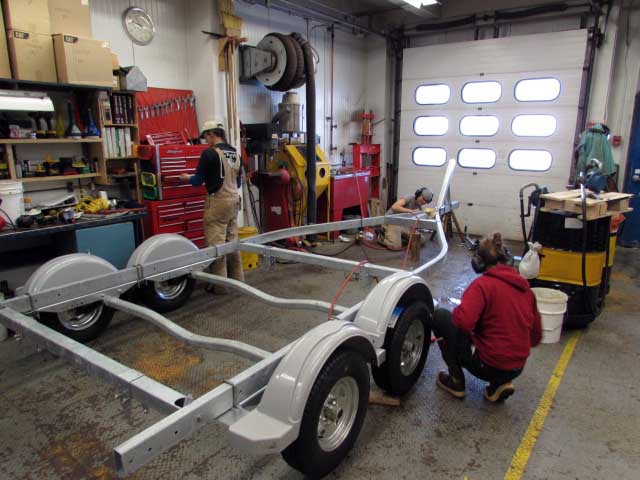
Photo Credit: Bob DeValentino
Marine technicians from the GOULD build a boat trailer in the Palmer Station garage.
The research vessel Laurence M. Gould The vessel also transported hazardous waste north to Chile for transfer to the Gould’s sister ship, the Nathaniel B. Palmer The waste will be temporarily staged at the port in Punta Arenas until the Palmer collects it in January for transport to McMurdo Station While everyone was very busy this month, time was still found for a bit of fun, including the second annual “Ant-ART-ica” art festival, with several dozen entries. The pieces on display included photographs, drawings and sculptures. The weather at Palmer remained fairly steady during August. The departure of the vessel was followed by an influx of sea ice, filling Hero Inlet and the waters all the way out to the local islands and beyond. Several days of cold temperatures and accompanying clear blue skies treated those on station to spectacular views of the mountains on the Antarctic Peninsula to the south. A couple of minor weather systems did pass through, however, dumping enough snow to keep us busy with shoveling and giving the new snow blower-equipped Bobcat vehicle a workout. The winter is definitely coming to a close, with just 19 support staff and two grantees remaining on station until the first of the summer crew arrives on Sept. 17. The station community is currently working on close-out tasking and final clean-up of station and work areas, while simultaneously winding down multiple winter projects. All are in good spirits and looking forward to rounding out yet another terrific season. Scientists studying Antarctic fish working out of Palmer Station during winterAugust 8, 2014
Palmer Station The science teams, led by principal investigators Christina Cheng The science teams have been busy dissecting, examining and preserving their fish samples, looking at Antarctic notothenioids and their ability to survive freezing temperatures. The Gould and the science teams had been out fishing twice during July and will remain at Palmer until they pack up and head north on Aug. 17. The weather was a mix of mild and wild, with several days well below freezing, accompanied by howling winds. We also experienced a few “bluebird” days of mild temperatures and little to no breeze. Snow has been accumulating around station, and many mornings start with a blanket of powder, giving the station a fresh, calm look. A few intrepid skiers have even taken advantage of the snowfall and hiked up the glacier behind station to cut some turns. Morale is high, due to a great mix of people, as well as increased daylight hours, granting a peek at the sun for longer and longer each day. Several social events kept things light during the month, including a performance by the Palmer Station Band and a magnificent Fourth of July dinner that included two smoked pigs and lots of tasty desserts. Palmer Station enjoys brief lull during Midwinter before science returnsJuly 18, 2014
Palmer Station Air and sea temperatures cooled, and a low-pressure system hung around the area for 10 days. The sea began to freeze, first taking hold in smaller areas like Hero Inlet, and eventually extending throughout Arthur Harbor and beyond. The increasingly solid sea ice tamped down the energy of the sea. The fur and elephant seals that remained in the area kept pace with the solidifying ice, moving from their favorite haunts on Bonaparte Point to areas closer to the ice edge. Due to both sea ice conditions and increasingly short daylight hours, boating activities ceased and outdoor recreational activities were limited to the lunch hour, or were performed sporting headlamps. In the six weeks between research cruises, Palmer residents had a chance to get to know each other even better in this small community. Monthly training sessions for the Search and Rescue and Fire teams lent opportunities to solidify teamwork skills. The Palmer Iron Chef competition showcased the culinary talents of four chefs who labored for one rushed hour to produce at least two dishes that incorporated a secret ingredient (in this case, chilies). The rest of the community eagerly participated as enthusiastic judges. On one calm winter Sunday, some top ropes were placed on the receding glacier face behind the station, allowing us to test our ice-climbing skills. And these were just a taste of some of the interesting and fun times we had together. Midwinter Day, the traditional Antarctic holiday that blends the milestones of mid-season and Winter Solstice, was celebrated June 20. The dining room was transformed with one long banquet table. Decorating the walls were the flags of the 12 original Antarctic Treaty nations, as well as those flags that uniquely identified members of the community. With the elegant tones of classical violin, the evening commenced with a cocktail hour. Guests wandered into a surprising assortment of appetizers that even included some fresh apple and carrot, some 11 weeks after the last arrival of freshies. The chef created an elaborate multiple-course meal, served family-style. Several types of sushi were artistically presented to the table, with a palate cleanser of wasabi ice cream. Main course items of salmon, asparagus, and potatoes were delivered to the table, and as the pièce de résistance, the leg of guanaco was carved table-side by chef Mike. Dinner was completed by an amazing assortment of elaborately crafted dessert offerings that pleased every palate. Several toasts were raised, to the continuation of a successful winter season together, to the various sacrifices made to take part in this Palmer winter season, and to the fantastic efforts of the chef. Just as we waited for the turning of the sun and the return of longer days, we started to expect the return of the research vessel Laurence M. Gould Palmer Station population drops to 19 for remainder of winterJune 23, 2014
Weather is the master over most human activity in Antarctica. In May, Palmer Station Mild temperatures were experienced throughout the month, averaging 0.9 degrees Celsius. There was little snowfall, and no sea ice formed during May. With the warmth came gusty winds of the type that can throw you off your feet, whip open doors, or send untethered objects into the air. For 10 days the winds gusted above 40 knots, reaching a maximum of 60 knots. The boom of the calving glacier was a consistent background sound, as the glacier donated pieces of brash ice to Arthur Harbor. Such was May along the Antarctic Peninsula, the “banana belt” of the continent. The mild, though windy, conditions allowed the special projects teams to progress toward the completion of their respective tasks: upgraded pier facilities, a wide boat ramp, parking decks for the Zodiacs, and a new antenna tower in the “backyard.” During the first half of the month, the research vessel Laurence M. Gould Station schedules revolve around the coming and going of the Gould, requiring many hands for line handling during the docking and undocking of the ship, for fish offload after a fishing cruise, and for cargo operations. As the scientists diligently finished their projects, station personnel prepared for the departure of the Gould on May 15. Leading up to that departure, Palmer Station had several events bringing the entire community together. In addition to the regularly scheduled science lectures, the science community hosted several “show and tell” events to share details of their work. Many informal gatherings of jamming musicians, contented movie watchers, spirited dancers, competitive Ping-Pong players, and energetic outdoor enthusiasts spontaneously arose to enjoy free time at Palmer Station. To cap off our time together, an all-station talent show was held, highlighting in one evening a surprisingly diverse array of abilities. With more than half the Palmer population headed back to South America with the Gould, the station diminished from maximum capacity with overflowing numbers berthing on the Gould to 19 winter-overs who will remain for the duration of the winter season. A mellower winter pace settled onto the station. Everyone had a little more elbow room, spreading out into single rooms. The galley was reconfigured with fewer seats into a homey family room setting. The laboratories were eerily quiet. Activities focused on keeping the station running, as always, and in getting ready for the next southbound cruise at the end of June. By the end of May, the air and sea temperatures reluctantly began to drop into a more wintery regime. Palmer Station makes the transition to winter as new personnel arriveMay 23, 2014
April is the beginning of the winter season at Palmer Station With the departure of the summer staff in late March, the winter-over crew quickly took over the reins, falling into their professional roles, as well as various community responsibilities. In this small community, each person wears many hats. Upon arrival to the station, assignments are made for the various teams that keep the station safe and functioning: Ocean Search and Rescue (OSAR), Glacier Search and Rescue (GSAR), line handling for the ships, fire team, and trauma team. A dozen extra personnel were on station all month working on special projects to maintain and upgrade Palmer facilities. Throughout the month, notable visual progress was made around station on the pier facility, the expansion the boat ramp, erection of antennae, and interior painting. Mid-month welcomed the return of the research vessel Laurence M. Gould Meanwhile, the scientists on station raised an antenna that detects waves from lightning worldwide, and worked on equipment that monitors radionuclides from the atmosphere. Weather-wise Palmer was treated to the entire gamut of conditions. Temperatures fluctuated all month above and below the freezing point, bringing alternating periods of driving rain and accumulating snow, mixed in with beautiful, clear, calm, sunny patches. Several periods of high winds helped move ice around the area, driving a rather large iceberg into very close vicinity of the pier and the Gould. At one point, all eyes were on the berg as it nudged closer and closer to the Gould on the incoming tide. This, and other, iceberg visitors moved in and out of the area all month. Nature is telling us that we are in the winter season. Daylight diminishes by about five minutes with each passing day. The local animals are becoming fewer and fewer, abandoning the local area for the winter months. But we humans are slow to get the message, as we toil away, full of energy and activity at the beginning of the winter season at Palmer. Summer field season at Palmer wraps up – but more science to come in winterApril 24, 2014
It’s a wrap. The month of March at Palmer Station Among the groups that departed was the birders, a team that is part of the Palmer Long Term Ecological Research (LTER) program Photo Credit: Kerry Kells/Antarctic Photo Library
Scientist Bill Fraser, head of the "birders" team for the Palmer LTER, measures a brown skua chick in 2012.
Other scientists who headed north in March included researchers with other components of the Palmer LTER, as well as researchers studying phytoplankton, krill, carbon accumulation in moss, and ground water inputs into the ocean. It was a busy season, by the numbers, at Palmer Station, with a total of 11 research teams working at Palmer Station at some point during the austral summer months. The station also supported two artists through the National Science Foundation’s Artists and Writers Program The last tourist cruise ships also visited in March, along with British ships RRS James Clark Ross and the HMS Protector. Altogether, the station hosted 15 cruise ships, yachts or military vessels over the summer, with personnel making four off-shore visits to larger cruise ships for outreach presentations. The Gould, of course, was the most frequent visitor, making 11 port calls over the course of the summer. The winter season promises to be no less busy, with five new science groups expected at Palmer Station in April. A stormy, wet February gave way to a drier but colder March, with the temperature dropping almost a degree lower than last month. The high temperature for March was 42 degrees Fahrenheit, with a low of 25F. The glacier near Palmer Station continued calving at a steady pace, dumping large amounts of ice into the waters of Arthur Harbor. Ice of land origin, plus swaths of brash ice and occasional bergy bits, were seen on most days. Additionally, a moderate-sized ice berg appeared off the station around mid- month. By the end of March it had broken into three pieces and grounded itself, just south of the station. Signs of winter appearing at Palmer StationMarch 7, 2014
The Palmer Long Term Ecological Research (LTER) For now, though, science is still going strong. Sea ice is no longer an issue as it was earlier this summer for the teams that use Zodiac inflatable boats to access islands or sample the ocean water. The biggest factor hindering off-station research is the wind, as the weather slowly changed over the past month. Days filled with high winds, rain, and even snow are becoming more common each week. The newborn wildlife has quickly grown before our eyes, and many animals have started to leave the area. The Adélie chicks have lost their downy feathers and now more closely resemble their parents in both size and coloring. Their voices have yet to change, and if not for the white on the underside of their necks, one would be hard-pressed to differentiate them from the adults. The sheathbills that have nested on station have successfully bred. Chicks now can be seen with the adults walking about station exploring the world outside of the nesting areas. Soon, they too will be soaring in the skies – or at least giving it their best try. Early in the month, large amounts of krill in the waters around station attracted large numbers of crabeater seals. One small iceberg in the area had 50 different seals sleeping on it. There was so much food that leopard seals were seen napping just feet from the crabeater seals. The research vessel Laurence M. Gould Also on the Gould were the rest of the team members of a group sampling the ocean and ground, investigating the pathways through which fresh water enters the ocean. They hope their data will provide some clues as to the origin of the fresh water, such as underground streams, surface streams or even as glacial meltwater. Several ships visited Palmer during February, including a visit from the Aquillies, a ship in the Chilean Navy. Several crewmembers from the Aquilles came ashore for a tour of Palmer. In turn, several Palmer Station residents got a chance to visit the Aquillies. As February comes to an end, the summer science season gets just a little bit closer to its end. Soon the winter crew will be here on station for turnover, and summer will officially be over. Palmer LTER project takes center stage in JanuaryFebruary 14, 2014
January marks the start of the New Year, but at Palmer Station The LTER cruise is the biggest annual research project that happens at Palmer. Each year the research vessel Laurence M. Gould 
Photo Credit: Sean Bonnette
An ocean glider is released into the sea from a Zodiac near Palmer Station.
The long-term observations help create a historical picture of part of the Antarctic Peninsula region, which is undergoing rapid environmental changes. Not all samples for LTER are taken from the Gould; some are taken from near Palmer Station by Zodiac. LTER projects range from taking water column samples, launching gliders, dragging nets for krill, to counting seabirds (including penguins), whales and seals. In addition to the LTER, a number of other science projects are very much active on station this summer. There are a few new groups at Palmer. One team has set up coastal radar installations to chart ocean currents. This information can be used to learn more about the currents and flow of the ocean around Palmer, but also can be used to see what boating conditions are like far from the station, predict what the sea ice coverage is like, or even predict areas where krill – and their predators – might be located. Test sites have been set up at the station and at two clusters of islands away from Palmer. The other new research team here this season spends much of its time sampling water, from both the ground and the ocean. The group is hoping to learn more about the path fresh water takes into the sea to determine if it is mainly from glacier melt or from unknown underground rivers and streams. Scientists collect hundreds to thousands of gallons of water, which is run through filters to concentrate the indicators that they are looking to analyze. With the sea ice now gone, the ocean surrounding Palmer has gone from clear to murky with the phytoplankton bloom. This brings the krill out to feast, and also the top predators that depend on the krill. Sightings of whales, seals and penguins in the area have been increasing. In addition to the common humpback and minke whales, orcas or killer whales have been seen near station. The number of crabeater seals has also exploded. It has become hard to find any flat ice floes in the area without at least one or two sleeping on it. There have even been reports of leopard seals sharing the same ice floes. Torgersen Island opened back up in January, enabling visits to the Adélie penguin colonies. The chicks that hatched in December are quickly approaching the same size as their parents. Sea ice clears out for research to get under way at Palmer StationJanuary 17, 2014
December was a turning point for many here at Palmer Station Last month, the ice was thick enough that five people scheduled to head north were left stranded at Palmer after the research vessel Laurence M. Gould They didn’t remain stuck for long. On Dec. 5, they were able to board a cruise ship for the ride north. The sea ice prevented the ship’s passengers from visiting the station, but it opened up just enough for those stuck at Palmer to get into a Zodiac and travel through a channel of water opened up by the ship’s bow thrusters. Researchers could finally work away from station as the ice broke away. In the Palmer boating area, there are a bunch of GPS points where science groups will return to lower instruments into the sea to take samples from the water column. One team that focuses on seabirds as part of the larger Palmer Long Term Ecological Research (LTER) The Palmer Station footprint changed drastically in December. Gone from the pier area are the numerous shipping containers used for storage. As part of a project to install a boat ramp at Palmer, the containers needed to be relocated to make room for future boat storage. Some of the containers have been moved behind the GWR building, while the containers related to the processing of the hazardous waste on station have been moved up the hill closer to the storage locations of the processed waste. As part of the boat ramp project, work has also continued to break up many of the large rocks in and around the landing area to facilitate the completion of the ramp at the end of the summer and into the winter. In order to remove the rocks, various methods are being used – expanding grout, rock splitters, and drills. The granite proved too tough to be removed by jackhammer over the winter, but seems to be giving way to the new methods. Thanks to the many holidays that take place in December, there was quite a bit to celebrate besides the sea ice going away. Rather than celebrate each holiday individually, special meals where held on the appropriate nights, with a gift swap near the end of the month. The gift swap at Palmer follows the form of a White Elephant or Yankee swap. Each person submits a “present,” and people take turns picking and stealing gifts from one another. Many of the gifts are handcrafted, and the creativity is often overwhelming. The gifts this year ranged from a guitar built from junk, recycled glass turned into a glass set, cutting boards, a handcrafted knife, and handmade sweets. While it doesn’t replace spending the holidays with friends and family, a Palmer holiday celebration places a close second. |
Home /
Around the Continent /
Palmer Station Archives - 2014
"News about the USAP, the Ice, and the People"



For USAP Participants |
For The Public |
For Researchers and EducatorsContact UsNational Science FoundationOffice of Polar Programs Geosciences Directorate 2415 Eisenhower Avenue, Suite W7100 Alexandria, VA 22314 Sign up for the NSF Office of Polar Programs newsletter and events. Feedback Form |

